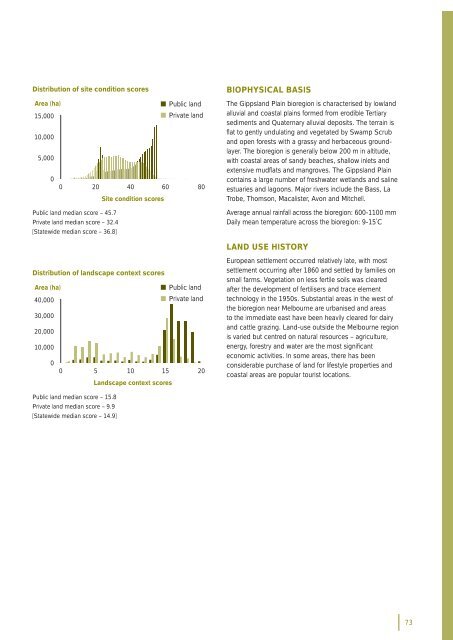findings by bioregion - Victorian Environmental Assessment Council
findings by bioregion - Victorian Environmental Assessment Council
findings by bioregion - Victorian Environmental Assessment Council
You also want an ePaper? Increase the reach of your titles
YUMPU automatically turns print PDFs into web optimized ePapers that Google loves.
Distribution of site condition scoresArea (ha)• Public land15,000• Private land10,0005,00000 20 40 60 80Site condition scoresPublic land median score – 45.7Private land median score – 32.4[Statewide median score – 36.8]BIOPHYSICAL BASISThe Gippsland Plain <strong>bioregion</strong> is characterised <strong>by</strong> lowlandalluvial and coastal plains formed from erodible Tertiarysediments and Quaternary alluvial deposits. The terrain isfl at to gently undulating and vegetated <strong>by</strong> Swamp Scruband open forests with a grassy and herbaceous groundlayer.The <strong>bioregion</strong> is generally below 200 m in altitude,with coastal areas of sandy beaches, shallow inlets andextensive mudfl ats and mangroves. The Gippsland Plaincontains a large number of freshwater wetlands and salineestuaries and lagoons. Major rivers include the Bass, LaTrobe, Thomson, Macalister, Avon and Mitchell.Average annual rainfall across the <strong>bioregion</strong>: 600-1100 mmDaily mean temperature across the <strong>bioregion</strong>: 9-15˚CLAND USE HISTORYDistribution of landscape context scoresArea (ha)40,000• Public land• Private land30,00020,00010,00000 5 10 15 20Landscape context scoresEuropean settlement occurred relatively late, with mostsettlement occurring after 1860 and settled <strong>by</strong> families onsmall farms. Vegetation on less fertile soils was clearedafter the development of fertilisers and trace elementtechnology in the 1950s. Substantial areas in the west ofthe <strong>bioregion</strong> near Melbourne are urbanised and areasto the immediate east have been heavily cleared for dairyand cattle grazing. Land-use outside the Melbourne regionis varied but centred on natural resources – agriculture,energy, forestry and water are the most signifi canteconomic activities. In some areas, there has beenconsiderable purchase of land for lifestyle properties andcoastal areas are popular tourist locations.Public land median score – 15.8Private land median score – 9.9[Statewide median score – 14.9]73
















